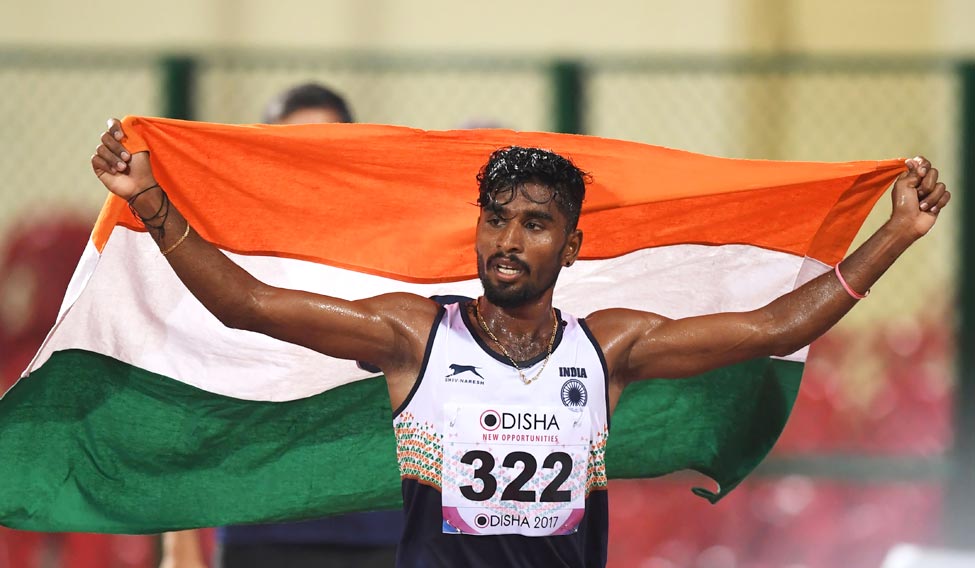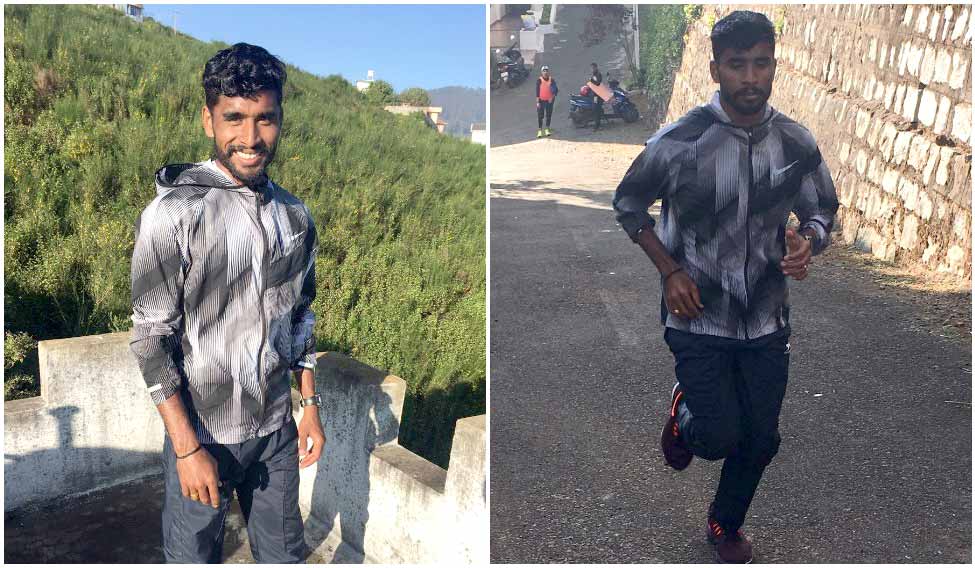Look at him closely and you will see tiny, intense black eyes, shining back at you. The wispy beard gives him the look of an ancient warrior, always raring to go. His walk is always brisk, more so after finishing one of his punishing 5,000m and 10,000m runs. Usually he wins, at least on the domestic and Asian circuit.
Irrespective of the result, the contented smile is a constant reminder of an athlete completely in love with his work and surroundings. In a nation like ours, where we treat athletes like outsiders or worse, mavericks—P.T. Usha and a few being the exceptions—Govindan Lakshmanan is India’s king of the 5,000m and 10,000m. Like his coach, Surender Singh, says, “He is 99 per cent on the podium at the 2018 Jakarta Asian Games.”
Yet, the Asian champion is not feted. The media doesn’t care, or worse, isn’t aware of him. At high altitude in Ooty, where he trains, they have been laying a tartan track; it just never gets finished. So, India’s number one, the man on whom we now rely to get us gold at the Asian Games, trains on cinder tracks and runs through the streets of this touristy town in Tamil Nadu. Ooty is around 2,300m above sea level—perfect for strengthening those lungs and heart.
When he won the 5,000m at the Asian Athletic Championships (AAC) in Bhubaneswar this year in 90 per cent humid conditions, he stood at the end of the track giving interviews while sweat poured down his chest and shoulders. The timing wasn’t great at 14:54.48. Much below his timing at the AAC 2013 in Pune. But, in the interview after the race, Lakshmanan said, “London [World Championships 2017] will be different. It’s just too humid and the competition is not there to push me.”
Question is how can an athlete run a personal best at a World Championship where, apart from Olympic and World Champion Mo Farah, there would be Muktar Edris, the former world U-20 champion and the fastest 5,000m runner of 2017 with a best of 12:55.23. And that field would still have Tanzania’s Emmanuel Gisamoda, Australia’s Morgan McDonald, Kenya’s Davis Kiplangat, Azerbaijan’s Hale Ibrahimov and Uganda’s Jacob Kiplimo. Confronted with such a line-up, all that is left to do is take selfies with some of the world’s greatest running stars. Lakshmanan’s answer to that was straight and simple: “I only know Mo Farah, the rest are just names and I have never run against them. So, there is no stress.”
In a field that runs around 13 and below, how does one survive with the pressure of the entire world watching? Indian athletes by nature don’t perform at the World Championships or the Olympics. But, Lakshmanan’s coach was adamant that if the race was run properly, Lakshmanan would, in fact, prosper and even do a personal best. For an Indian, the personal best is the medal.
The top six in the world run in Europe and have competitions against the best at least once a month. Their training schedules are monitored by an army of support staff whose sole aim is to clip off 4-5 seconds per season leading to timings that get you on to the podium. Lakshmanan’s sole aim was to hang in the middle and not to let go. It was a one-point plan. Get stuck into the middle of the race and stay close to the inside lane. There is no way that Surender or Lakshmanan thought he would qualify for the final. Athletes from more than a hundred nations try and make it to the Worlds and even there, the elite 40 odd nations finally get on to the track. Countries like Kenya, Uganda sometimes have multiple athletes. There was no attention on a tiny Indian man who suddenly shot into the middle of the pack and refused to let go of the inside lane. In the qualifying heat, 21 runners started. Spain’s Illia Fifa, the European Champion hit the front, Farah at the back, in the middle, Lakshmanan. Too far up would mean pushing untested limits against runners whose lungs could stretch beyond a normal human’s capability. Being stuck at the back would ensure fighting for the lower spots and a real bad time.
Surender had clearly put together the right tactics. Lakshmanan stuck like a limpet to the inside lane, running steadily and keeping pace within the top runners. The big guns—Gisamoda, McDonald, Kiplangat and Ibrahimov—exchanged the lead. Farah moved from the back and started powering upfront. Lakshmanan was in around 14-16th position. Too many bodies were in front. Going from the outside would be an extra 4-6 metres and it would kill him. Surender later said, “I hoped Lakshmanan wouldn’t try and race the top pack as that would finish off his legs.” Lakshmanan wasn’t doing any of that. He was hell bent on a personal best. His best was 13:36.62.
Meanwhile, Farah had moved and the rest went with him, powering away. The pace was astonishing. A gap did open up with the lead pack increasing pace but Lakshmanan didn’t fall for that. He didn’t have the lungs and that stage in the race, your mind plays games. In the rain and bone-chilling cold, Lakshmanan ran his hand and body coordination almost perfect, the pace consistent, and all the marks of a good long distance runner. But physically, inside, he was in agony. With his body literally on fire, he kept on. Later he would say, “Legs tight ho gaya tha (The legs had tightened up).”
Kejelcha crossed the line in 13:30.07 Farah stopped the clock at 13:30.18 as did Edris, who was just 4/100ths behind. Big names also got eliminated—Kiplimo, Kiplangat and Bahrain’s Albert Rop wouldn’t run in the final. Five seconds later, Lakshmanan crossed the line. Exactly five seconds behind some of the world’s greatest runners. The pessimistic would say, five seconds take a life time. Yes they do, but in a race where you have promised to do a personal best, it is akin to winning a medal. It takes high quality racing to bridge gaps.
 (File) Lakshmanan celebrates after winning the gold in the men's 5,000m race at the Asian Athletics Championships at Kalinga Stadium in Bhubaneswar | AFP
(File) Lakshmanan celebrates after winning the gold in the men's 5,000m race at the Asian Athletics Championships at Kalinga Stadium in Bhubaneswar | AFP
In Ooty, running on cinder with no competition except trying to be the best in Asia, is not enough. Year after year of running against the big guys gives you the vision and the guts to take them on. London for Lakshmanan was a watershed moment. At least, he knew he had it in him. And when the timings and positions flashed on the scoreboard, elation filled him—he had broken his own personal best with 13:35.69!
Later on, in the mixed zone, the smile never left his face as he spoke about the race. The smile became a grin when he said: “I ran with Mo Farah. It is his last championship and I will always remember that.”
Some time back, in an interview with a leading daily, the Pandya brothers—Krunal and Hardik—had said they used to eat Maggi while playing junior cricket, a sentiment which should have moved the nation to their plight. “Last night, I had boiled rice with tomato sauce,” said Lakshmanan with a grin spread from ear to ear. Probably, the secret to his personal best. More than the diet of rice and tomato sauce, it is the vision of a man from Tamil Nadu running such races during the season in Europe that is so inspiring.
In September, at the 57th National Athletics, Lakshmanan picked up another double gold—in the 5,000m and 10,000m races. Training in Ooty, he said, “Right now, the Commonwealth and the Asian Games are coming and preparation should be good for them.” He is pounding away on the streets and alleys in the town doing 170/180km a week along with track running. “The tartan track is not ready here, so we also train on the ground at the St Lawrence School,” says Surender. The coach will move his group of runners to Bhutan in March, a month before departing for the Gold Coast in Australia where Lakshmanan will meet some of the finest from Africa and the United Kingdom. “The Commonwealth Games are like the Olympics only, very tough but we will try and do our best there,” says Surender.
Both athlete and coach understand that preparation is not the only priority. Funding is one thing. Also, understanding how you reach the podium is a science India needs to decipher. There was some hope that with an Olympic medallist as sports minister, avenues would open but when Rajyavardhan Singh Rathore said that India can produce 100 Usain Bolts, it is understood that an Asian champion slogging away in Ooty is very far away from his mind space. Getting one Bolt has taken Jamaica almost 40 years and the next one could be another half a century away. Rathore wants to produce 100 Bolts!
But Surender is confident that when they apply to train and run in Europe, the Ministry and Sports Authority of India would see value in it. Till then, Lakshmanan is an outcast, an outlaw and a fringe athlete running down the streets in a quest for glory; the smile and grin, his only performance enhancing drugs.





